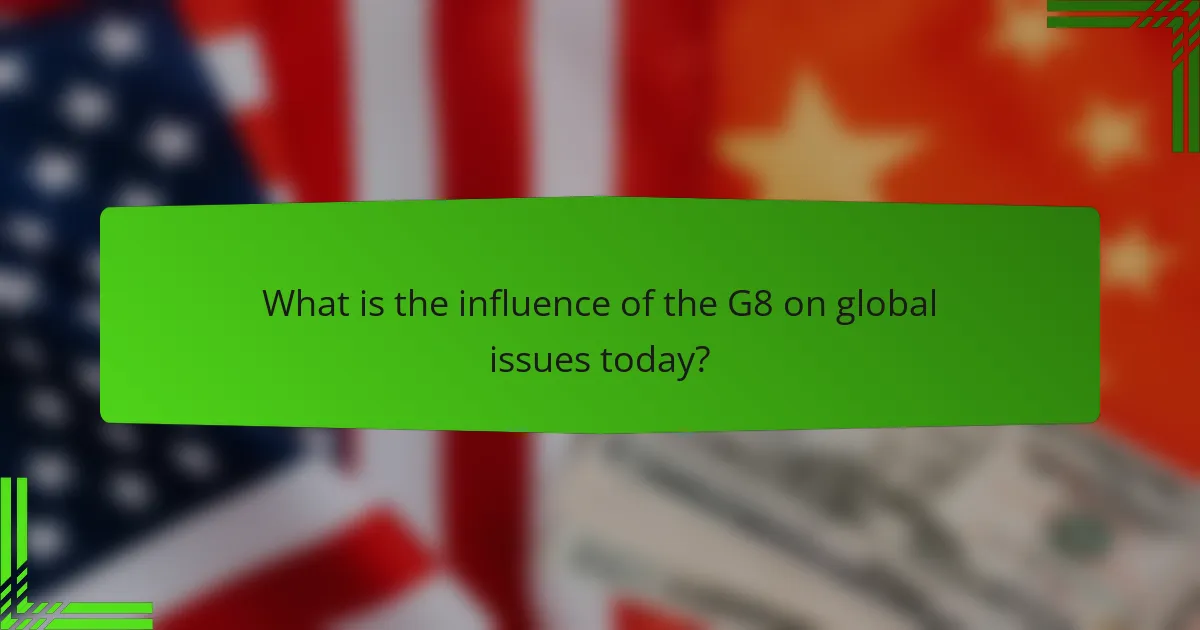The G8 Summit is an annual meeting of leaders from eight major industrialized nations: Canada, France, Germany, Italy, Japan, Russia, the United Kingdom, and the United States. Established in 1975 as the G6 and evolving to include Canada and Russia, the summit focuses on global economic governance, international security, and energy policy. Although Russia’s membership was suspended in 2014, the G8, now functioning as the G7, continues to address critical global issues, including climate change and economic stability. The summit’s historical significance lies in its role in shaping international policies and facilitating cooperation during global crises, despite ongoing criticism regarding its exclusivity and effectiveness.

What is the G8 Summit and its historical significance?
The G8 Summit is an annual meeting of leaders from eight major industrialized nations. These nations include Canada, France, Germany, Italy, Japan, Russia, the United Kingdom, and the United States. The summit focuses on global economic governance, international security, and energy policy. It was established in 1975 as the G6, initially including France, Germany, Italy, Japan, the UK, and the USA. Canada joined in 1976, making it the G7. Russia was added in 1998, creating the G8. The historical significance of the G8 Summit lies in its role as a platform for discussing pressing global issues. It has influenced international policies on climate change, trade, and development. The summit has also facilitated cooperation in response to crises, such as the 2008 financial crisis. Throughout its history, the G8 has evolved in response to changing global dynamics and has faced criticism for its exclusivity.
How did the G8 Summit originate?
The G8 Summit originated from the 1975 G6 meeting. This initial meeting included leaders from France, Germany, Italy, Japan, the United Kingdom, and the United States. The purpose was to discuss economic issues following the 1973 oil crisis. Canada joined in 1976, expanding the group to the G7. In 1998, Russia was invited, creating the G8. The G8 aimed to address global economic governance and policy coordination among major industrialized nations.
What were the initial goals of the G8 Summit?
The initial goals of the G8 Summit were to facilitate economic cooperation among the world’s major industrialized nations. The summit aimed to address global economic issues and promote stability. It focused on fostering dialogue on international economic policy. Additionally, the G8 sought to enhance collaboration in areas like trade and development. The first summit took place in 1975, originally involving six countries. Canada joined in 1976, expanding the group to seven. The inclusion of Russia in 1998 further transformed the summit into the G8. This evolution reflected the changing dynamics of global politics and economics.
Who were the founding members of the G8?
The founding members of the G8 were Canada, France, Germany, Italy, Japan, the United Kingdom, and the United States. These nations first convened in 1975 as the G6. They aimed to discuss economic issues and coordinate policies. In 1976, Canada joined, expanding the group to the G7. Russia was added in 1998, making it the G8. This membership structure emphasized collaboration among major industrialized nations.
What role does the G8 Summit play in global governance?
The G8 Summit plays a crucial role in global governance by facilitating dialogue among major industrialized nations. It addresses pressing global issues such as economic stability, security, and environmental challenges. The summit provides a platform for leaders to coordinate policies and foster collaboration. Established in 1975, it originally included six nations and expanded to eight. The G8 influences international policies through consensus-building and joint declarations. Its decisions impact global economic strategies and development initiatives. The summit’s significance has evolved, especially with the rise of emerging economies, leading to discussions about its relevance. Despite criticisms, the G8 remains a key player in shaping global governance frameworks.
How does the G8 influence international policies?
The G8 influences international policies through collective decision-making among its member countries. This group includes major advanced economies that shape global economic governance. The G8 addresses pressing global issues such as security, trade, and climate change. It sets agendas that impact international agreements and frameworks. The G8 also facilitates dialogue between member states, enhancing cooperation on shared challenges. Decisions made at G8 summits can lead to policy shifts in non-member countries as well. Historical examples include the G8’s role in the Paris Agreement discussions. The influence of the G8 is evident in its ability to mobilize resources for global initiatives.
What are the key issues addressed at the G8 Summit?
The key issues addressed at the G8 Summit include global economic stability, international security, and climate change. Leaders discuss strategies to promote sustainable economic growth. They address security concerns such as terrorism and nuclear proliferation. Climate change discussions focus on reducing greenhouse gas emissions. Health issues, including pandemics and global health initiatives, are also significant topics. Development aid and poverty reduction are prioritized in discussions. Trade policies and international cooperation are frequently reviewed. These issues reflect the evolving challenges facing member nations.

How has the membership of the G8 evolved over time?
The membership of the G8 has evolved significantly since its inception. Originally formed in 1975 as the G6, it included France, Germany, Italy, Japan, the United Kingdom, and the United States. Canada joined in 1976, expanding the group to the G7. Russia was added in 1998, creating the G8. However, Russia’s membership was suspended in 2014 due to its annexation of Crimea. This action effectively reverted the group back to the G7. The G7 continues to focus on economic policies and global issues among its seven member countries.
What changes have occurred in G8 membership since its inception?
The G8 membership has changed since its inception in 1975. Initially, it consisted of six countries: France, Germany, Italy, Japan, the United Kingdom, and the United States. Canada joined in 1976, expanding the group to seven members. Russia was invited to join in 1998, making it the G8. However, following Russia’s annexation of Crimea in 2014, the group reverted to the G7 format, excluding Russia. Currently, the G7 comprises Canada, France, Germany, Italy, Japan, the United Kingdom, and the United States.
Which countries have joined or left the G8?
The G8, originally known as the Group of Eight, has seen changes in its membership over the years. Canada, France, Germany, Italy, Japan, Russia, the United Kingdom, and the United States were the founding members. Russia was suspended in 2014, effectively reducing the group to the G7. No new countries have joined since Russia’s suspension. The G7 continues to focus on economic and political issues among these seven nations.
What factors contributed to changes in G8 membership?
Changes in G8 membership were influenced by geopolitical shifts, economic factors, and global crises. The end of the Cold War altered international relations, prompting the inclusion of Russia in 1997. Economic disparities among member nations also played a role, as emerging economies sought representation. The 2008 financial crisis led to discussions about reforming the G8 structure, emphasizing the need for broader representation. Additionally, the rise of the G20 as a more inclusive forum for global economic governance diminished the G8’s relevance. These factors collectively shaped the evolving landscape of G8 membership.
How does the current membership reflect global power dynamics?
The current membership of the G8 reflects global power dynamics by showcasing the influence of major economies. The G8 includes nations like the United States, Canada, and Japan, which are historically significant in global trade. Their economic strength and political power shape international policies. The inclusion of emerging economies in discussions illustrates a shift in influence. Countries like China and India are not G8 members but are increasingly relevant in global affairs. This indicates a transition from Western dominance to a more multipolar world. The current membership structure emphasizes economic interdependence and collaborative governance. It also highlights the need for representation of diverse perspectives in addressing global challenges.
What are the implications of including emerging economies?
Including emerging economies in the G8 Summit can enhance global representation and influence. It acknowledges the economic growth of countries like Brazil, India, and China. Their inclusion can lead to more balanced discussions on global issues. Emerging economies contribute diverse perspectives on trade, climate change, and security. This shift can foster collaboration on pressing global challenges. Research indicates that emerging markets now account for over 50% of global GDP. Their participation reflects changing economic realities and power dynamics. This evolution can strengthen the legitimacy of the G8 in a multipolar world.
How does membership affect a country’s influence in the G8?
Membership in the G8 significantly enhances a country’s influence in global economic and political discussions. Being part of the G8 provides access to high-level dialogues among leading industrialized nations. This access allows member countries to shape international policies and agreements. For instance, decisions made during G8 summits often set the agenda for global economic governance. Countries like Canada and Japan have leveraged their G8 membership to advocate for specific trade policies. Furthermore, membership enhances a nation’s diplomatic credibility on the world stage. The G8 platform facilitates collaboration on pressing issues such as climate change and security. Thus, membership directly correlates with a country’s ability to influence global matters.

What is the influence of the G8 on global issues today?
The G8 influences global issues today primarily through economic coordination and policy discussions. It addresses critical topics such as climate change, security, and economic stability. The G8 facilitates dialogue among major industrialized nations, promoting consensus on international policies. For instance, the G8 has played a role in shaping responses to global financial crises. It also impacts development aid strategies, particularly in Africa. The G8’s influence is evident in its ability to mobilize resources for health initiatives like the Global Fund to Fight AIDS, Tuberculosis, and Malaria. Although the G8 has faced criticism for its effectiveness, it remains a significant platform for addressing pressing global challenges.
How does the G8 address contemporary challenges?
The G8 addresses contemporary challenges through collaborative discussions and policy-making. Member countries focus on global issues such as economic stability, security, and climate change. They convene annually to assess progress and set priorities. The G8 promotes coordinated responses to crises like financial downturns and pandemics. It also engages in dialogue with non-member nations and international organizations. This inclusive approach enhances global governance. For instance, the G8’s 2009 summit addressed the financial crisis with coordinated fiscal stimulus measures. Such actions demonstrate its commitment to tackling pressing global challenges effectively.
What are the key global issues currently on the G8 agenda?
The key global issues currently on the G8 agenda include climate change, global health, and economic stability. Climate change remains a pressing concern, with the G8 focusing on reducing greenhouse gas emissions. Global health issues, particularly in response to pandemics, are prioritized for collaborative solutions. Economic stability is essential for recovery and growth, especially post-COVID-19. Additionally, the G8 addresses international security and geopolitical tensions. These issues reflect the G8’s commitment to global cooperation and sustainable development.
How effective is the G8 in addressing climate change?
The G8 has had a mixed effectiveness in addressing climate change. Initially, the G8 focused on economic growth, often sidelining environmental issues. However, since the early 2000s, climate change has gained prominence in their agenda. The 2005 Gleneagles Summit emphasized the need for action on climate change and energy security. The G8 nations committed to halving global greenhouse gas emissions by 2050. Despite these commitments, actual progress has been inconsistent across member countries. For instance, the 2015 Summit in Germany reaffirmed climate commitments but lacked binding agreements. The G8’s influence has waned with the rise of the G20, which includes emerging economies. Overall, while the G8 has raised awareness, its effectiveness is limited by the lack of enforceable actions.
What criticisms have been leveled against the G8?
Criticisms against the G8 include its perceived lack of legitimacy and representativeness. Critics argue that the G8 only includes a small number of wealthy nations. This exclusion leads to an imbalance in global decision-making. The group has also faced accusations of ineffectiveness in addressing critical global issues. For example, economic disparities and climate change remain persistent challenges. Additionally, some believe the G8 prioritizes the interests of its member states over global needs. This has sparked calls for a more inclusive approach, such as expanding to the G20. The G8’s ability to enact significant policy changes has often been questioned.
What are the main arguments against the G8’s relevance?
The main arguments against the G8’s relevance include its limited representation and effectiveness in addressing global issues. Critics argue that the G8 does not include emerging economies. Countries like China and India, which are significant players in the global economy, are excluded. This exclusion raises questions about the G8’s legitimacy in representing global interests.
Additionally, the G8’s decision-making process is often seen as slow and bureaucratic. This inefficiency hampers its ability to respond swiftly to crises. Furthermore, the G8’s focus has shifted over time. Many believe it has become less relevant compared to other forums like the G20, which includes a broader range of nations.
Lastly, there is a perception that the G8 prioritizes the interests of member countries over global needs. This perception undermines its authority and effectiveness in international governance. Collectively, these arguments suggest that the G8 may no longer be the appropriate platform for addressing contemporary global challenges.
How do critics view the G8’s decision-making process?
Critics view the G8’s decision-making process as opaque and exclusive. They argue that it lacks transparency, limiting public understanding and accountability. Decisions are often made behind closed doors, raising concerns about democratic legitimacy. Critics also highlight the dominance of major powers, which can overshadow the interests of smaller nations. This concentration of power can lead to decisions that do not reflect global consensus. Additionally, some analysts note that the G8’s effectiveness has diminished over time. They argue that its relevance is questioned in a multipolar world. These views are supported by various studies and reports analyzing the G8’s impact and decision-making dynamics.
What best practices can enhance the G8’s effectiveness?
Enhancing the G8’s effectiveness can be achieved through improved communication and collaboration among member nations. Regular and transparent dialogue fosters trust and understanding. Establishing specific, measurable goals for each summit can focus efforts and resources. Engaging with non-member countries can broaden perspectives and solutions. Utilizing technology for real-time data sharing can enhance decision-making. Evaluating past summits for lessons learned can inform future strategies. Incorporating feedback from civil society can ensure diverse viewpoints are considered. These practices can lead to more impactful outcomes and stronger global cooperation.
The G8 Summit is an annual meeting of leaders from eight major industrialized nations, focusing on global economic governance, international security, and energy policy. Established in 1975 as the G6, the summit evolved to include Canada and Russia, becoming the G8. The article explores the historical significance of the G8, its role in global governance, the evolution of its membership, and the key issues it addresses, such as climate change and economic stability. It also examines criticisms of the G8 and its effectiveness in influencing international policies amidst changing global dynamics.